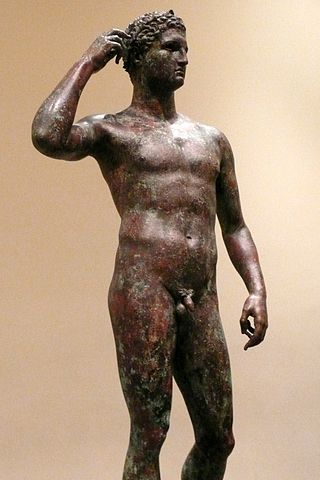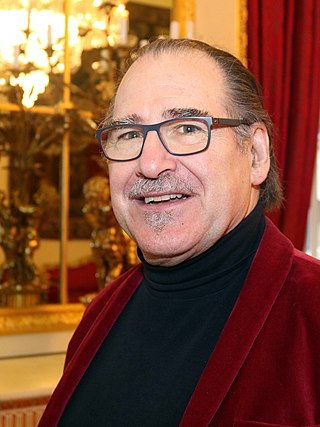Karol B. Wight is a museum administrator and is currently the president and executive director of The Corning Museum of Glass. She specializes in the field of ancient glass.
Karol B. Wight is a museum administrator and is currently the president and executive director of The Corning Museum of Glass. She specializes in the field of ancient glass.
Wight received her PhD from the University of California Los Angeles in art history. [1] Her doctoral thesis was on the topic of "Mythological beakers and Roman glass production in the first century A.D." [2]
In 2011, Wight was appointed executive director of The Corning Museum of Glass, a museum with a collection of 45,000 glass objects that represent the history, science and art of glass. In 2015 she was appointed president and executive director of the museum. [3] [1] Prior to this appointment, she was senior curator of antiquities at the J. Paul Getty Museum in Malibu, California. [3] She is also curator of ancient and Islamic glass at the museum. [4] Prior to that she held the position of senior curator of antiquities at the J. Paul Getty Museum's Getty Villa in Malibu, California. Over a period of 26 years she held various positions at the Getty. [1]
In 2017, President Barack Obama appointed Wight to an advisory post on the Cultural Property Advisory Committee of the U.S. Department of State. [5]
Wight has published articles [6] and books on ancient glass objects and glass making techniques. [7] Among them are the book, Molten color: glassmaking in antiquity. [8]

Glassblowing is a glassforming technique that involves inflating molten glass into a bubble with the aid of a blowpipe. A person who blows glass is called a glassblower, glassmith, or gaffer. A lampworker manipulates glass with the use of a torch on a smaller scale, such as in producing precision laboratory glassware out of borosilicate glass.

The Villa of the Papyri was an ancient Roman villa in Herculaneum, in what is now Ercolano, southern Italy. It is named after its unique library of papyri, discovered in 1750. The Villa was considered to be one of the most luxurious houses in all of Herculaneum and in the Roman world. Its luxury is shown by its exquisite architecture and by the very large number of outstanding works of art discovered, including frescoes, bronzes and marble sculpture which constitute the largest collection of Greek and Roman sculptures ever discovered in a single context.

The J. Paul Getty Museum, commonly referred to as the Getty, is an art museum in Los Angeles, California housed on two campuses: the Getty Center and Getty Villa.
The J. Paul Getty Trust is the world's wealthiest art institution, with an estimated endowment of US$7.7 billion in 2020. Based in Los Angeles, California, it operates the J. Paul Getty Museum, which has two locations—the Getty Center in the Brentwood neighborhood of Los Angeles and the Getty Villa in the Pacific Palisades neighborhood of Los Angeles. Its other programs are the Getty Foundation, the Getty Research Institute, and the Getty Conservation Institute.

Venetian glass is glassware made in Venice, typically on the island of Murano near the city. Traditionally it is made with a soda–lime "metal" and is typically elaborately decorated, with various "hot" glass-forming techniques, as well as gilding, enamel, or engraving. Production has been concentrated on the Venetian island of Murano since the 13th century. Today Murano is known for its art glass, but it has a long history of innovations in glassmaking in addition to its artistic fame—and was Europe's major center for luxury glass from the High Middle Ages to the Italian Renaissance. During the 15th century, Murano glassmakers created cristallo—which was almost transparent and considered the finest glass in the world. Murano glassmakers also developed a white-colored glass that looked like porcelain. They later became Europe's finest makers of mirrors.

The Getty Villa is at the easterly end of the Malibu coast in the Pacific Palisades neighborhood of Los Angeles, California, United States. One of two campuses of the J. Paul Getty Museum, the Getty Villa is an educational center and museum dedicated to the study of the arts and cultures of ancient Greece, Rome, and Etruria. The collection has 44,000 Greek, Roman, and Etruscan antiquities dating from 6,500 BC to 400 AD, including the Lansdowne Heracles and the Victorious Youth. The UCLA/Getty Master's Program in Archaeological and Ethnographic Conservation is housed on this campus.
Frederick Carder was a glassmaker, glass designer, and glass artist who was active in the glass industry in both England and the United States, notably for Stevens & Williams and Steuben, respectively. Known for his experimentation with form and color, Carder's work remains popular among collectors and can be found in numerous museum collections, including The Corning Museum of Glass, which houses the Frederick Carder Gallery, Chrysler Museum of Art, and the Detroit Institute of Arts. He was born in Staffordshire, England, and died in Corning, New York, where he had made his home since 1903.
Cornelius Clarkson Vermeule III was an American scholar of ancient art and curator of classical art at the Museum of Fine Arts, Boston, from 1957 to 1996. He was also well known as a numismatist. He also used the pseudonyms Wentworth Bunsen, Isao Tsukinabe and Northwold Nuffler.

The Corning Museum of Glass is a museum in Corning, New York in the United States, dedicated to the art, history, and science of glass. It was founded in 1951 by Corning Glass Works and currently has a collection of more than 50,000 glass objects, some over 3,500 years old.

The Victorious Youth, Getty Bronze, also known as Atleta di Fano, or Lisippo di Fano is a Greek bronze sculpture, made between 300 and 100 BC, in the collections of the J. Paul Getty Museum, Pacific Palisades, California. Many underwater bronzes have been discovered along the Aegean and Mediterrean coast; in 1900 sponge divers found the Antikythera Youth and the portrait head of a Stoic, at Antikythera, the standing Poseidon of Cape Artemision in 1926, the Croatian Apoxyomenos in 1996 and various bronzes until 1999. The Victorious Youth was found in the summer of 1964 in the sea off Fano on the Adriatic coast of Italy, snagged in the nets of an Italian fishing trawler. In the summer of 1977, The J. Paul Getty Museum purchased the bronze statue and it remains in the Getty Villa in Malibu, California. Bernard Ashmole, an archaeologist and art historian, was asked to inspect the sculpture by a Munich art dealer Heinz Herzer; he and other scholars attributed it to Lysippos, a prolific sculptor of Classical Greek art. The research and conservation of the Victorious Youth dates from the 1980s to the 1990s, and is based on studies in classical bronzes, and ancient Mediterranean specialists collaboration with the Getty Museum. The entire sculpture was cast in one piece; this casting technique is called the “lost wax” method; the sculpture was first created in clay with support to allow hot air to melt the wax creating a mold for molten bronze to be poured into, making a large bronze Victorious Youth. More recently, scholars have been more concerned with the original social context, such as where the sculpture was made, for what context and who he might be. Multiple interpretations of where the Youth was made and who the Youth is, are expressed in scholarly books by Jiri Frel, Paul Getty Museum curator, from 1973 to 1986, and Carol Mattusch, Professor of Art History at George Mason University specializing in Greek and Roman art with a focus in classical bronzes.
Marion True was the former curator of antiquities for the J. Paul Getty Museum in Los Angeles, California. True was indicted on April 1, 2005 by an Italian court, on criminal charges accusing her of participating in a conspiracy that laundered stolen artifacts through private collections and creating a fake paper trail; the Greeks later followed suit. The trial brought to light many questions about museum administration, repatriation, and ethics.

Stanislav Libenský and Jaroslava Brychtová were contemporary artists. Their works are included in many major modern art collections, such as the Metropolitan Museum of Art and the Victoria & Albert Museum.

A rummer was a type of large drinking glass studded with prunts to ensure a safe grip, popular mainly in the Rhineland and the Netherlands from the 15th through the 17th century. Rummers lacked the flared bowl of the Berkemeyer and had much thinner walls. The hollow base was built up by coiling strands of molten glass around a conical core. Römers were quite distinct from the Berkemeyers, but both types evolved from the German "cabbage stalk" glasses which were cylindrical with prunts. Römers are usually green in colour and with Berkemeyers were sometimes engraved with images and inscriptions.

The Getty kouros is an over-life-sized statue in the form of a late archaic Greek kouros. The dolomitic marble sculpture was bought by the J. Paul Getty Museum, Los Angeles, California, in 1985 for ten million dollars and first exhibited there in October 1986.
Dr Robert Brill is in the field of archaeological science, best known for his work on the chemical analysis of ancient glass. Born in the United States of America in 1929, Brill attended West Side High School in Newark, New Jersey, before going on to study for his B.S. degree at Upsala College. Having completed his Ph.D. in physical chemistry at Rutgers University in 1954, Brill returned to Upsala College to teach chemistry. In 1960, he joined the staff of the Corning Museum of Glass as their second research scientist
Thelma Golden is the Director and Chief Curator of The Studio Museum in Harlem, New York City, United States. Golden joined the Museum as Deputy Director for Exhibitions and Programs in 2000 before succeeding Dr. Lowery Stokes Sims, the Museum's former Director and President, in 2005. She is noted as one of the originators of the term Post-Blackness.
James "Jim" Bash Cuno is an American art historian and curator. From 2011–22 Cuno served as President and Chief Executive Officer of the J. Paul Getty Trust.
Charlotte Nalle Eyerman is an American museum director and curator and expert in 19th century French art. She was appointed Director and Chief Curator of the JPMorgan Chase art collection in 2017. She is a member of the board of trustees at Accountability Lab. Eyerman has also served as Director and chief executive officer of the Monterey Museum of Art (2010–2013), and as Director of the Gagosian Gallery, Beverly Hills.

Jack Ogden, FSA, FGA, is a British jewellery historian with a particular interest in the development of Materials and technology. He is considered one of the foremost experts in his field. He is the current President of The Society of Jewellery Historians, having held the position since February 2018, and was appointed Visiting Professor of Ancient Jewellery, Material and Technology, at the Birmingham School of Jewellery Birmingham City University in 2019
Peggy Fogelman is the Norma Jean Calderwood Director of the Isabella Stewart Gardner Museum in Boston, Massachusetts. Fogelman has served in this role since January 2016, after Anne Hawley stepped down after 26 years as director of the museum, and she is the museum's fifth director.